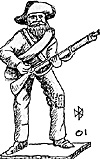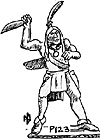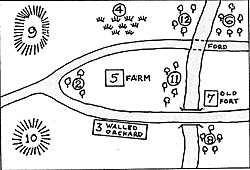 This is a scenario that will give some real battlefield problems and can be used in any period. It is for a force of government troops to travel through hostile country held by three guerrilla bands.
This is a scenario that will give some real battlefield problems and can be used in any period. It is for a force of government troops to travel through hostile country held by three guerrilla bands.
Initially the guerrillas will be out of sight and will not appear until after the government column has move on to the table. Any type of terrain will do, providing there are at least eleven locations that might be considered suitable to hide small groups of figures. These might be farm buildings, woodland, hilltops or stone walls. Each of these location should be numbered from 2 to 11. The most important strategic sites being marked 5,6,8 and 9, as they are the most likely numbers to be scored when rolling two normal dice.
 There are fewer ways of scoring 2,3,4,10,11 and 12 and these are sites of less importance. Each of these positions is a possible location for one or more guerrilla band. Although there are eleven positions only the maximum of three will be used. There are six different combinations of how to score a seven, so this number is selected for the site of the objective. For this scenario it will be an old vacant fort. I say vacant as there are no troops garrisoned there at present. If it has fallen into rebel hands will be assessed during the game.
There are fewer ways of scoring 2,3,4,10,11 and 12 and these are sites of less importance. Each of these positions is a possible location for one or more guerrilla band. Although there are eleven positions only the maximum of three will be used. There are six different combinations of how to score a seven, so this number is selected for the site of the objective. For this scenario it will be an old vacant fort. I say vacant as there are no troops garrisoned there at present. If it has fallen into rebel hands will be assessed during the game.
When travelling through any hostile country there is always the chance of attack when least expected. So at the beginning of each game move a set of percentage dice is rolled. If the score is fifty or less then one of the guerrilla groups has been activated. This is continued each move until all three groups have been revealed.
When a group is activated, roll two normal dice to determine at which strategic point they are located. They can then be placed on the table. Should any government force hold any of these points and a guerrilla group is later activated on the same position, the guerrillas will dice again for one that is unoccupied.
 Large Version of map (slow: 65K)
Large Version of map (slow: 65K)
GOVERNMENT PATROL ORDERS. They are to entry from the west side of the table and proceed to the old fort. On arrival they are to burn down the fort and return to their base to the west.
When the column moves onto the table, some thought on how they should be deployed will not go amiss. Flank and rear guards will come into their own. It can be good idea to send forward troops to take possession of the more important locations before they are activated by the guerrillas.
GUERRILLA GROUPS ORDERS. If the government troops should cross the river before any guerrilla group is activated, all three groups will come onto the table from separate position determined by the dice, in the same game move.
All guerrilla groups are to prevent the government patrol reaching the old fort.
If any group is activated by the bridge over the river, (position 8) they will attempt to destroy it before advancing on the enemy.
Any group reaching the old fort will hold the position until the government troops have been driven from the area.
Guerrillas will always attack the nearest troops if the enemy are in more than one formation. When a guerrilla group is activated there should be some chance factor to see if they attack immediately or hold their fire until the next bound. Character valuing for the leaders of each group will be of benefit.
NUMBER OF FIGURES. I suggest the total guerrilla force is one third larger than the government troops. So if 24 figures make up the column there will be three groups of guerrillas of 12 figures each, attacking them from different angles.
I have tried out this game many times and it always has a new twist each time I play. The patrol can be Romans, Confederate cavalry or a modern commando group. Whatever the period it makes a good solo game.
Back to Table of Contents -- Lone Warrior #119
Back to Lone Warrior List of Issues
Back to MagWeb Magazine List
© Copyright 1997 by Solo Wargamers Association.
This article appears in MagWeb (Magazine Web) on the Internet World Wide Web.
Other military history articles and gaming articles are available at http://www.magweb.com
